
interaction geometries between tris-ethylenediamine metal cations and the oxalate dianion. These components have a mismatch in shape: the H-bond donor having three D–H groups and a three-fold character, while the acceptor can only present two accepting groups and has a two-fold character. This
clear conflict of symmetry between the H-bond donor and the H-bond acceptor moieties results in a compromised interaction in which we frequently observe a side-on interaction with the oxalate and the formation of uncommon bifurcated H-bonds. This interaction ranges from being quite symmetric with two similar H…O interactions, to an asymmetric situation with one short and one long H…O interaction.
Read more for FREE until the 9th December at:
Recurrent H-bond graph motifs between metal tris-ethylenediamine cations and uncoordinated oxalate anions: Fitting a three pin plug into a two pin socket
Tony D. Keene, Michael B. Hursthouse and Daniel J. Price
CrystEngComm, 2011, Advance Article
DOI: 10.1039/C1CE05837A
Keep up to date with the latest news and research in solid-state and crystalline materials: sign up to the CrystEngComm e-alert, follow us on Twitter, and like us on Facebook.











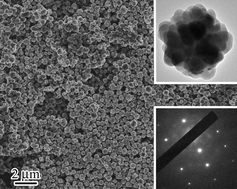 In this HOT article, Chinese researchers report the synthesis and properties of spherical assemblies of NaYF4 nanocrystals via a facile solution-based method. Their novelty lies in the unique structural geometry of the NaYF4 assemblies attached together along one specific crystalline orientation. The impact of organic additives such as citric acid and polyvinylpyrrolidone on the crystal growth was investigated in detail and a possible formation mechanism is also proposed. This interesting hierarchical structure not only offers a high surface area and easy modification surface, but also provides a new efficient host for doping various lanthanide ions to give strong down- or up-conversion emissions. It is anticipated that these unique assembled NaYF4 nanostructures will serve as biolabels in various biomedical applications.
In this HOT article, Chinese researchers report the synthesis and properties of spherical assemblies of NaYF4 nanocrystals via a facile solution-based method. Their novelty lies in the unique structural geometry of the NaYF4 assemblies attached together along one specific crystalline orientation. The impact of organic additives such as citric acid and polyvinylpyrrolidone on the crystal growth was investigated in detail and a possible formation mechanism is also proposed. This interesting hierarchical structure not only offers a high surface area and easy modification surface, but also provides a new efficient host for doping various lanthanide ions to give strong down- or up-conversion emissions. It is anticipated that these unique assembled NaYF4 nanostructures will serve as biolabels in various biomedical applications.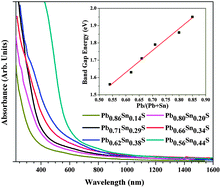 In this HOT article, Chinese researchers have demonstrated for the first time that ternary cation-alloyed PbSnS nanocrystals could be synthesized via a facile solution-based routine. The mean diameters of the as-prepared nanocrystals ranged from 6–15 nm. Several interesting variations on the crystal structure and band gap energy were indicated. The results could potentially have a high impact on IV-VI quantum dots based optoelectronic applications in the future.
In this HOT article, Chinese researchers have demonstrated for the first time that ternary cation-alloyed PbSnS nanocrystals could be synthesized via a facile solution-based routine. The mean diameters of the as-prepared nanocrystals ranged from 6–15 nm. Several interesting variations on the crystal structure and band gap energy were indicated. The results could potentially have a high impact on IV-VI quantum dots based optoelectronic applications in the future. The outside cover features research by Yang et al. Highly symmetric polyhedral 50-facet Cu2O homogeneous structures enclosed by 24 high-index {211} facets, and 8 low-index {111} facets, 6 low-index {100} facets and 12 low-index {110} facets have been synthesized via a facile seed-mediated solution phase route.
The outside cover features research by Yang et al. Highly symmetric polyhedral 50-facet Cu2O homogeneous structures enclosed by 24 high-index {211} facets, and 8 low-index {111} facets, 6 low-index {100} facets and 12 low-index {110} facets have been synthesized via a facile seed-mediated solution phase route.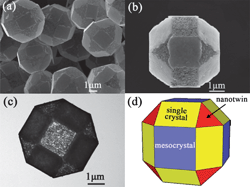 In this HOT article, Chinese researchers synthesized novel polyhedral 26-facet CuS microcages decorated with unique crystalline structures as building blocks via a facile sacrificial Cu2O templates solution route. Each of the polyhedral 26-facet CuS microcages is constructed of three different structural shells, which are enclosed by three pairs of square mesostructural shells, four pairs of nanotwinned triangular shells, and six pairs of rectangular single crystalline shells. The study should be of great importance for the “bottom-up” assembly of unusual hollow ordering superstructures.
In this HOT article, Chinese researchers synthesized novel polyhedral 26-facet CuS microcages decorated with unique crystalline structures as building blocks via a facile sacrificial Cu2O templates solution route. Each of the polyhedral 26-facet CuS microcages is constructed of three different structural shells, which are enclosed by three pairs of square mesostructural shells, four pairs of nanotwinned triangular shells, and six pairs of rectangular single crystalline shells. The study should be of great importance for the “bottom-up” assembly of unusual hollow ordering superstructures.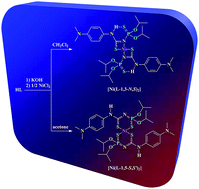 In this HOT article, Babashkina and co-workers have synthesized the first examples of NiII complexes containing the same asymmetric NTT [(N-(thio)phosphorylated thioamides and thioureas RC(S)NHP(X)(OR0)2 (X ¼ O, S)] ligand featuring an aryl-NH substituent at the thiocarbonyl group and coordinating to the metal both in the 1,3-N,S- and 1,5-S,S’-fashion in the solid state depending on the crystallization conditions.
In this HOT article, Babashkina and co-workers have synthesized the first examples of NiII complexes containing the same asymmetric NTT [(N-(thio)phosphorylated thioamides and thioureas RC(S)NHP(X)(OR0)2 (X ¼ O, S)] ligand featuring an aryl-NH substituent at the thiocarbonyl group and coordinating to the metal both in the 1,3-N,S- and 1,5-S,S’-fashion in the solid state depending on the crystallization conditions.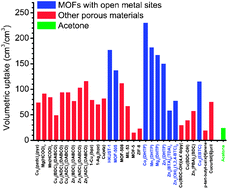 Acetylene is an important starting material in the petrochemical and electronic industry for various industrial and consumer products, and a promising alternative energy source for future acetylene fuel cell vehicles. With the importance of acetylene, as a green fuel, this CrystEngComm Highlight, focuses on the storage of acetylene and its separation from the CO2, CH4, or C2H4 mixtures on micro-porous metal–organic frameworks (MOFs).
Acetylene is an important starting material in the petrochemical and electronic industry for various industrial and consumer products, and a promising alternative energy source for future acetylene fuel cell vehicles. With the importance of acetylene, as a green fuel, this CrystEngComm Highlight, focuses on the storage of acetylene and its separation from the CO2, CH4, or C2H4 mixtures on micro-porous metal–organic frameworks (MOFs).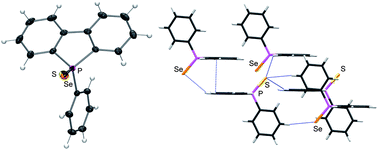 In this HOT article, the solid-state interactions of dibenzophosphole chalcogenides and their potential application as electron transporting materials were investigated. The crystallographic properties of 9-phenyl-9-dibenzophosphole chalcogenides were compared with the mixed crystal structure and optical properties of 9-phenyl-9-dibenzophosphole sulphideselenide. The mixed crystal displayed desirable properties, i.e. carrier transport and emission properties, and this approach may be useful in the future for optoelectronic applications such as light-emitting SC-OFETs
In this HOT article, the solid-state interactions of dibenzophosphole chalcogenides and their potential application as electron transporting materials were investigated. The crystallographic properties of 9-phenyl-9-dibenzophosphole chalcogenides were compared with the mixed crystal structure and optical properties of 9-phenyl-9-dibenzophosphole sulphideselenide. The mixed crystal displayed desirable properties, i.e. carrier transport and emission properties, and this approach may be useful in the future for optoelectronic applications such as light-emitting SC-OFETs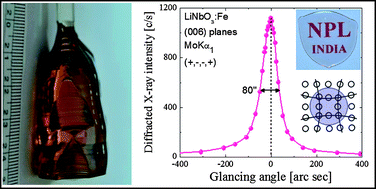 Lithium niobate (LN), a nonlinear optical material in its single crystal form, is well proven as a potential and unique material for its use in advanced photonic device applications like second-harmonic generation, optical switching, optical modulators, holographic data storage, acousto-optic and ferroelectric. The transition and rare earth metal ions (Fe, Mn, Cuand Ce) improve the data storage capabilities of LN by improving its photorefraction efficiency. However, when the concentration of dopants in the crystal increase, high geometric strains develop in the lattice resulting in the agglomeration of point defects, the formation of dislocations finally leading to structural boundaries. These defects mask or partially/completely deteriorate some of the anisotropic physical properties of the single crystals and reduce the efficiency of the devices made out of these crystals.
Lithium niobate (LN), a nonlinear optical material in its single crystal form, is well proven as a potential and unique material for its use in advanced photonic device applications like second-harmonic generation, optical switching, optical modulators, holographic data storage, acousto-optic and ferroelectric. The transition and rare earth metal ions (Fe, Mn, Cuand Ce) improve the data storage capabilities of LN by improving its photorefraction efficiency. However, when the concentration of dopants in the crystal increase, high geometric strains develop in the lattice resulting in the agglomeration of point defects, the formation of dislocations finally leading to structural boundaries. These defects mask or partially/completely deteriorate some of the anisotropic physical properties of the single crystals and reduce the efficiency of the devices made out of these crystals.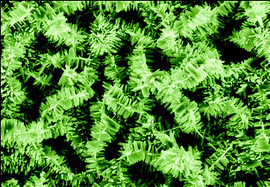 In this HOT article, ZnO nanorods were helped to “stand” vertically on microsubstrates by an interesting seed-mediated approach. Taking ZnO nanosheets as the microsubstrates, ZnO nanorods can grow vertically, not lying horizontally, on the facets with the aid of a seed layer precoating to form hierarchical ZnO nanorod-nanosheet architectures. The diameter as well as the length of the standing nanorods can be controlled effectively by adjusting the growth time and the amount of ammonia in the growth solution. The precoated seed layer has been found to be the key factor in determining the resultant morphology.
In this HOT article, ZnO nanorods were helped to “stand” vertically on microsubstrates by an interesting seed-mediated approach. Taking ZnO nanosheets as the microsubstrates, ZnO nanorods can grow vertically, not lying horizontally, on the facets with the aid of a seed layer precoating to form hierarchical ZnO nanorod-nanosheet architectures. The diameter as well as the length of the standing nanorods can be controlled effectively by adjusting the growth time and the amount of ammonia in the growth solution. The precoated seed layer has been found to be the key factor in determining the resultant morphology.